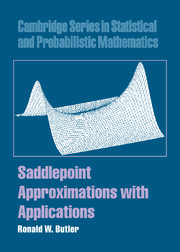Book contents
- Frontmatter
- Contents
- Preface
- 1 Fundamental approximations
- 2 Properties and derivations
- 3 Multivariate densities
- 4 Conditional densities and distribution functions
- 5 Exponential families and tilted distributions
- 6 Further exponential family examples and theory
- 7 Probability computation with p*
- 8 Probabilities with r*-type approximations
- 9 Nuisance parameters
- 10 Sequential saddlepoint applications
- 11 Applications to multivariate testing
- 12 Ratios and roots of estimating equations
- 13 First passage and time to event distributions
- 14 Bootstrapping in the transform domain
- 15 Bayesian applications
- 16 Nonnormal bases
- References
- Index
5 - Exponential families and tilted distributions
Published online by Cambridge University Press: 25 February 2010
- Frontmatter
- Contents
- Preface
- 1 Fundamental approximations
- 2 Properties and derivations
- 3 Multivariate densities
- 4 Conditional densities and distribution functions
- 5 Exponential families and tilted distributions
- 6 Further exponential family examples and theory
- 7 Probability computation with p*
- 8 Probabilities with r*-type approximations
- 9 Nuisance parameters
- 10 Sequential saddlepoint applications
- 11 Applications to multivariate testing
- 12 Ratios and roots of estimating equations
- 13 First passage and time to event distributions
- 14 Bootstrapping in the transform domain
- 15 Bayesian applications
- 16 Nonnormal bases
- References
- Index
Summary
Exponential families provide the context for many practical applications of saddlepoint methods including those using generalized linear models with canonical links. More traditional exponential family applications are considered in this chapter and some generalized linear models are presented in chapter 6. All these settings have canonical sufficient statistics whose joint distribution is conveniently approximated using saddlepoint methods. Such approximate distributions become especially important in this context because statistical methods are almost always based on these sufficient statistics. Furthermore, these distributions are most often intractable by other means when considered to the degree of accuracy that may be achieved when using saddlepoint approximations. Thus, in terms of accuracy, both in this context and in the many others previously discussed, saddlepoint methods are largely unrivaled by all other analytical approximations.
The subclass of regular exponential families of distributions was introduced in section 2.4.5 by “tilting” a distribution whose MGF converges in the “regular” sense. Tilting combined with Edgeworth expansions provide the techniques for an alternative derivation of saddlepoint densities that is presented in this chapter. This alternative approach also gives further understanding as to why the saddlepoint density achieves its remarkable accuracy. Both unconditional and conditional saddlepoint approximations are considered for the canonical sufficient statistics in a regular exponential family. The computation of p-values for various likelihood ratio tests and the determination of some uniformly most powerful unbiased tests are some of the practical examples that are considered.
Regular exponential families
Definitions and examples
Let z be the data and denote Z as the random variable for the data before observation.
Information
- Type
- Chapter
- Information
- Saddlepoint Approximations with Applications , pp. 145 - 182Publisher: Cambridge University PressPrint publication year: 2007
